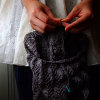With work, there hasn't been a lot of crafting going on, but I did have an absolutley amazing crafty weekend. I took some real time off for myself, something I seldom have the luxury of doing it seems these days. First off, a little weaving update, not a lot to report. |
 |
The Specs: The weaving is coming along painfully slow. Part of the problem is I only get to weave once a week, I have been absent as well as the teacher, and the other problem is that the headles on the loom unfortunately are cutting the dry spun linen so that my back is beginning to look like a torcher device of broken strings. So any small advances of the loom require resetting up all the spindles and the spools to regain tension. Even with very careful set up, the tension is also beginning to get off. So the back of the loom now has a group of knitting needles holding threads on top. |
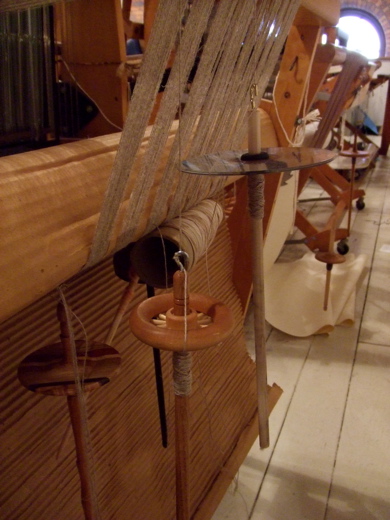 |
| Doesn't that look like a scary photo? I stopped this past week because two more threads were loosening up and I didn't feel like finding something to take up the slack. |
 |
So now on to the fun stuff. One of the girls in the weaving class was sweet enough to come up with a fiber day for any one who wanted to come this past weekend. L brought her amazing fleeces from this past springs cutting. They were the absolute nicest fleeces I think I have ever seen. They were clean, not greasy, and some of the prettiest colours. Here were two of her boy’s fleeces. All it did was make me really wish I could go pet a sheep and thank them for their beautiful fiber. L is truly a good mother to her sheep. I ended up buying one of the fleeces from her that was an amazing brown
and fawn colour. Her name was Cathy, after "Chatty Cathy," since
she is the loud one in the flock. I will post more photos when I try my
hand at breaking apart the folds and washing it this spring. I just need
to find some netting and safety pins. I cannot wait. It is destined for
a lace shawl. |
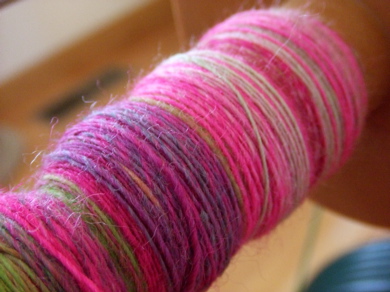 |
While there I spent the afternoon spinning and talking with friends. I finished up a ball of roving that I had started over the holidays and when I got home I was brave enough to try my hand at spinning hopefully sock weight for Mia. She sent me this roving at Christmas, so hopefully I can manage to spin her some sock yarn as a gift. It always amazes me to see how multi-colour roving spins up. You can never tell, or at least I cannot tell yet. The above is from one of Spunky Eclectic blends. I also started a mitten on Sunday night, but that will have to wait until there is a match for its debut before felting. L was sweet enough to bring me yarn, needles, and a pattern since she knew I always wanted to learn to knit mittens. Now my end product does look pretty funny. Have a great crafty week! |
Monday, March 26, 2007
kitty: a happy crafty weekend
Wednesday, March 21, 2007
MG: eponymous
eponymous (guess i was feeling cheeky when i started this sweater): pattern-based on Elizabeth Zimmermann's seamless raglan. knitted to my measurements; negative ease around the bust; postive ease around the upper arms. body knitted from the bottom up in the round, then cardiganized with a steek. sleeves knitted top down from provisional cast-ons at the yoke. yarn-four skeins (100 grams) of Araucania Nature Wool in color #03 (100% wool). thank you, Kitty Kitty! :) needles-4.25mm clover circular (US6) for stocking stitch in the body; 3.75 addi natura circular (US5) for ribbing in the body; 3.9mm clover mini circulars for upper sleeves; 4.5mm clover mini circular for lower sleeves; 2.25mm clover DPNs (US1)for ribbing on cuffs.
 trying to show you the decorative de/increases
trying to show you the decorative de/increases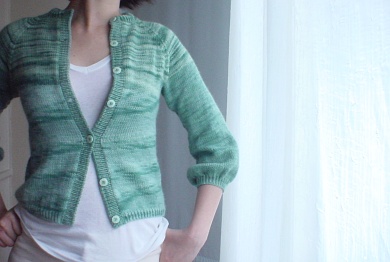
Monday, March 19, 2007
MG: in love with belly warmers

it started when i noticed the knitted tube around Grandpa Umatarou's tummy on Yakitate Japan. it looked like some sort of traditional tool of warmth. i thought it could be cute under the right circumstances and also a knitted hug for my tummy, so i googled about for history and examples to inform the one i'd like to knit.
they are called haramakis ("maki" like what you might order at a sushi restaurant, you know, to roll yourself up in) and thought to be good for cold hands and feet, stomach aches, cramps, etc. the same way a hot water bottle is good (especially if it comes in a knitted cozy).

then i found this PingMag article and became completely smitten by the super cute, modern Habonichi versions. i now want to knit a half-dozen of them: cabled ones, colorwork ones, argyle ones, ones for sleeping, ones to hide under a shirt, ones with pockets (b/c there are not enough pockets on women's clothing), even one with a passport pocket on the side against my belly. i love the orange one above. perusing other photos in the article, they work surprisingly well into everyday outfits. i wanna start one straight away.
i went button-hunting at Stonemountain and Daughter. there is an FO soaking away in conditioner at this very moment.
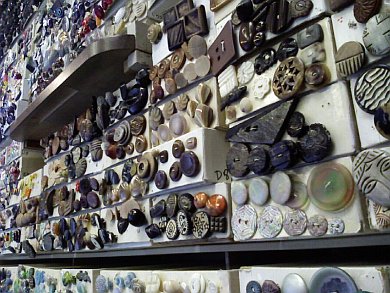
Sunday, March 18, 2007
kitty: Orenburg Lace
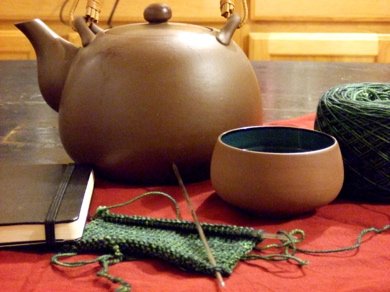 |
You know it is really kind of funny how a simple thing as going out for a cup of tea with your knitting can bring two knitters together. M and I went to our favorite teahouse here in Columbus and I was swatching for my St. Patrick's Day knitting project Twisted Flower Sock. I had great plans to sit Saturday afternoon and just knit. It wasn't like going out in Columbus this weekend would be a particularly fun with all the basketball traffic. Unfortunately, all I did was sit and work. It is pretty funny though we went out to grab groceries Saturday afternoon, and during the last 3 min of the OSU basketball game half of the cars on the interstate were swerving and going 45 - 50mph. This is an OSU sport town no doubt, but I digress. So I was setting there drinking a cup of tea and this Korean woman walked up to me and asked what I was knitting. I showed her Cookie's amazing pattern. The conversation then lead to the fact I have been obsessed with lace knitting as of late, and ended up talking about Orenburg Lace. As a child her Russian nanny had basically made her memorize and commit to memory the 12 basic patterns of Orenburg Lace. She stood there while she waited for tea and drew out the ones she remembered in my little notebook. I have never been so thankful for a piece of pen and paper. She then started to talk about the fact that when her nanny was a child; all children sat and learned how to knit and committed these simple patterns to memory. She remembered as a child knitting a sampler to perfect these simple stitches over and over again. Essentially all of the patterns were based on different order of yo and K2tog. Nothing was written down, no fancy charts, just simple zeros on a page that was written out before you started. It was something that you just assumed everyone knew how to do, so no need to record it. I then asked her if she minded if I posted the charts on my blog and she said feel free. "There are two few people in the world that knit any more and probably less than that know anything about Orenburg Lace." She just kept thanking me for being a young person who knits. It saddened her that her children show no interest in any form of crafts. Then she admitted the only thing she does today is Sudoku. So here is her very brief tutorial on the basic patterns: (There are
two others, that unfortunately I couldn't figure out how to chart from
her sketches. One was a chain of interlocking hearts that reminded me
much of the one in the Arctic Lace and the other one looks like an interlocking
chain of cats paws.) |
 |
"Honeycomb" - all over patterns |
 |
"Mouse Paws" - used for borders |
 |
"Fish Eyes" |
 |
"Strawberry"- her favorite |
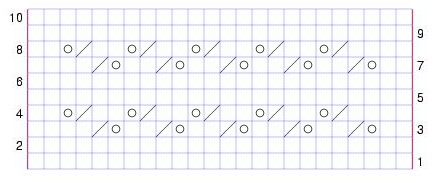 |
"Peas" - fill in corners |
 |
"Cat Paws" |
 |
"Accordion" |
Charts were created using a really
cool online "Chart
Creator" |
I now really want to find out as much as I can about Orenburg Lace. I was shocked when I did a quick google and there was very little information. It looks like there are only two books that I could find in English. I found one reference to an amazing Russian Reference book, but that was about it. And yes I quickly ordered two used copies of the two English titles when I found them. It just always amazes me when knitting brings two strangers together to start a conversation. I have had this happen many a time, but really it never ceases to amaze me. |
Books:  Gossamer
Webs: The History and Techniques of Orenburg Lace Shawls Gossamer
Webs: The History and Techniques of Orenburg Lace Shawls by Carol R. Noble (Author), Galina Khmeleva (Author) Interweave Press (November 1, 1998) ISBN-10: 1883010411 Ingram Annotation: Shawls are back, they're better than ever, and in Gossamer Webs, the only book available on intricate Russian shawl knitting, you'll find all the information you need to knit them! Gossamer Webs includes technical information, from the combing of goats for fiber to the spinning process to the basics of shawl design. Instructions for a miniature shawl prepare readers to knit the complete pattern for the Orenburg Eastern Shawl, pattern included. |
Ingram Annotation: |
| Skaska Designs - List of link to magazine publications |
Links on Orenburg Lace: History of Orenburg goat down knitted shawls Heriloom Knitting offers the Mohair and mini kits AC- The Peoples Media - The Lace Shawls of Orenburg in Russia Lavender Farm - Orenburg Lace Shawls from Russia (Check out the photo of the spindles and the link to the folktale's about spinners) Wabisabi: From Russia with Love - look at the wonderful find The Orenburg Down Shawl book |
Fun Lace Links: |
Saturday, March 17, 2007
kitty: Japanese Craft Books - 4893969536
| Japanese Craft Books - Amazon Jp - Hana Gifts |
 Updated: Making fashionable clothes from old fabrics and kimonos. Thanks MG for posting your translation in the comments! 106 pages - 2007/01 ISBN-13: 9784893969538 |
To be honest, I really have no hopes of ever fitting into any of the Japanese sewing patterns that I have bought in the past, but the books are so beautiful I always gravitate to them. This book basically takes the approach of having an amazing print fabric and combining it with a basic staple fabric. They explore the concept of taking a vintage expensive fabric and making a garment still affordable to construct the garment. I guess I was also envisioning using my hand woven with commercial fabrics or buying vintage kimono scraps. The book contains a lot of super cute designs; ranging from something you would wear about town, to the office, a formal evening at the ballet, or a summer garden party with a cute little cape. The first of the book is colour images of the garments, followed by the schematics for the designs. (I overlapped the sketch of the items below. They are not in the colour section of the book.) Then fold out patterns to trace. Contents: |

|
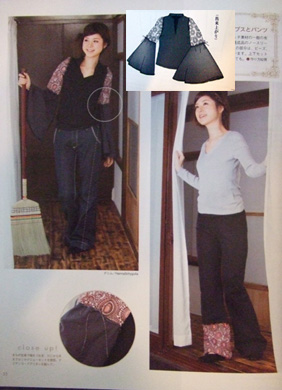 |
 |
kitty: Samplers - 0761303723
| Sampler Craft Books - Lerner Publishing |
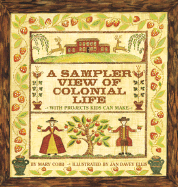 Sampler View Of Colonial Life by Mary Cobb 64 pages - Millbrook Press (September 1, 1998) ISBN-10: 0761303723 ISBN-13: 978-0761303725 |
Ingram Annotation: When buying used books you sometimes have to take a leap of faith and just order a book. I was talking to a used book distributor in the UK and she had a listing for this title. She was offering it pretty cheap, so I figured I would take a chance for my mom. The book looks at craft projects a young colonial American girl would have done; learning to weave, doing a sampler of stitches, making a wall pocket for the back parlor, and many others. The projects have been updated. The cross-stitch sampler was to be printed out for example. The stitches were very basic. But, I totally loved the book and think it would be a great book to introduce kids to crafting. Nothing like mixing a little bit of history with decades of history of crafting. The drawings are also pretty adorable. |
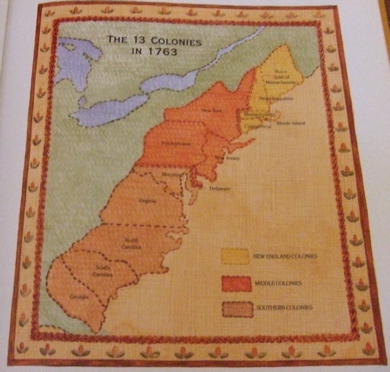
|
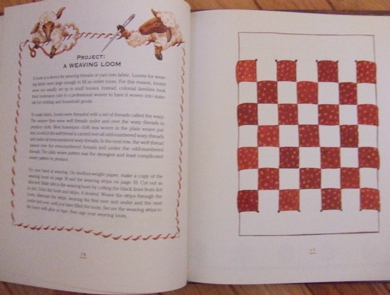 |
 |
Tuesday, March 13, 2007
MG: button-ready
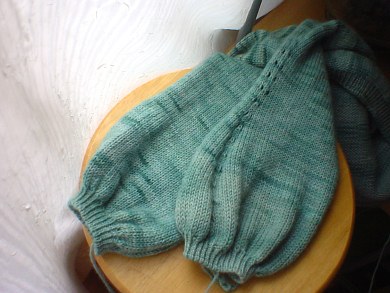
i have buttonbands--neat and trim buttonbands. photos below. words on picking up and finishing the steek at Zimmermania.

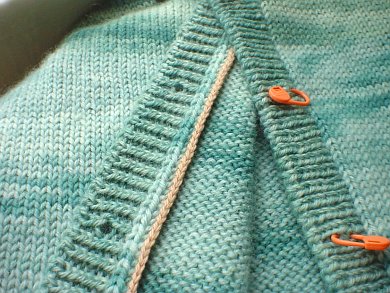
 [800x600version here]
[800x600version here]i need buttons. but i don't know which sort.
kitty: Knitters Treat Exchange
 Spring
sounds like a good time of year to sign up for another swap. I haven' t
signed up for one in awhile, and my friend Mia
passed this link to me a couple of days ago. So I signed up for the Knitters
Treat Exchange hosted by Tea and Cakes
and Tangelled Angel Knits. Spring
sounds like a good time of year to sign up for another swap. I haven' t
signed up for one in awhile, and my friend Mia
passed this link to me a couple of days ago. So I signed up for the Knitters
Treat Exchange hosted by Tea and Cakes
and Tangelled Angel Knits. |
||
| 1. What's your favorite type of yarn? I prefer natural and organic fibers.
For me, the key features are texture, interest, and hand. I covet anything
soft to the touch. I am intrigued by the unusual (fiber combination, texture,
or novelty) and of course anything cheetah print.
2. What's your least favorite type of yarn? I cringe at anything scratchy, itchy, and hard. 3. What's the first thing you do when you visit a new yarn shop? Check out to see if they carry habu yarns, fair trade yarns, organic fibers, and then hit the sock area. 4. What other crafts do you do / would like to do? I would say my area of true expertise is in 16th century Spanish Bead work. Worked blind and only through touch. |
||
|
||
5. What magazines do you currently subscribe to? Vogue Knitting, Interweave, Rowan, and Inspirations 6. Put this type of magazine in order of preference: Knitting / Food / Other Craft / Fashion / Garden / Crochet / Home / Celebrity Gossip 7. What items do you like to knit / crochet? I will knit just about anything, currently though I am on a lace and sock kick. 8. Are you allergic to anything? Yes; smoke, strong perfume, millinery arsenic, dairy, mold, anything citrus, and pollen 9. What do you like to smell of? Madagascan Vanilla, Lavender, Honey, Maple Sugar, and Camomile 10. What's your favorite way to relax? Long hot bath or knitting in bed with the kitties 11. You're stood in front of a Victorian style sweetshop, an Italian cafe, an old fashioned bakery and a dainty tea room. Where do you go first? Dainty tea room no questions asked. 12. What do you come out with? A lovely cup of some exotic sounding tea and a scone 13. Where do you go next? Victorian style sweetshop to get some hand pulled sugar or marzipan creation 14. Any other words of wisdom for your pal? knit knit knit |
Thursday, March 08, 2007
kitty: Weaving eye candy
 |
Weaving is coming along. Through many trials and tribulations, re threading the loom completely, and numerous threads breaking every time I turn around I am back on track. It is a little narrower than the piece I was weaving before. I really love the colour and the combination of the silk, hemp, and dry spun linen. So here is my little eye candy for the day. The plan is to still knit a table runner but I am begriming to doubt whether or not the linen will hold up long enough to finish the project. Re threading the threads has not be kind to there condition. |
Wednesday, March 07, 2007
kitty: Samplers
 |
Recently I have started to collect sampler books for my mom and one of her friends. Above is a little collection that I have ready to send her for Valentines Day. Yes, Yes, Yes, I am really late and if I don't hurry Asian Girls Valentines day will be over as well. I am just having a hard time finding time to get to the post office. The stack of stuff I need to mail is embarrassing. :( Sorry everyone. I have been thinking a lot about needlework and samplers, it is surprising when you think about it; the story of the sampler really is far from over. In a time when virtually all textiles are mass-produced and women are employed outside the home, there has been a revival in an interest in hand goods. Just think about all the craft bloggers out there. Though it pains me to say, embroidery and decorative arts that flourished prior to the Industrial Revolution can never again be regained. We have simply lost the skills and time needed for these arts. We are certainly coming a long way to restore the craft, but unfortunately it is seen more as a craft than fine art. Though there is a small group that is working on the "Heritage Industry" today, who keep at least some of the historical concepts alive. So what engrossed us in studding about samplers? Historically, samplers were the start of a lifetime of work. The word sampler was derived from the Latin - 'exemplum' which had a meaning of self-explanatory. So the meaning of sampler was the act of learning and recording of stitches. This is the aspect that really intrigues both my mother and me. Young children did a lot of the earliest samplers both English and Continental. The motifs that were popular were those of the areas of the world that you lived. For example; Crucifixion and Instruments of Passion are common in Catholic Europe, Orange Trees were popular in German and Danish borders, English samplers have heavy bands and repeat borders. I am far from an expert, but I have been reading a lot on the subject as of late. Especially in regards to knitted samplers and lace samplers. Knitted samplers were very practical items. They held an immediate practical
application for the knitter. They could be used as stockings, caps, gloves,
and other accessories need to keep one warm in the winter. Then when young
girls perfected their lace knitting, they could knit the band designs
into the ankles of their stockings so that it would be slightly visible
under their hemlines. You know how a racy ankle meant more than fully
exposed chest during the early 1800's. |
 |
Samplers from A to Z by Pamela A. Parmal |
kitty: Samplers: From the Victoria & Albert Museum - 1851773096
Ingram Annotation Samplers reveals a gallery of some of the most important and beautiful pieces in the V&A and is a unique opportunity to see close-up the fragile objects which cannot remain on permanent display or be seen in strong light. The book is international in scope and covers a wide range of stitch types, providing both practical information and a rich source of inspiration for designers and embroiderers. Kitty Kitty . |
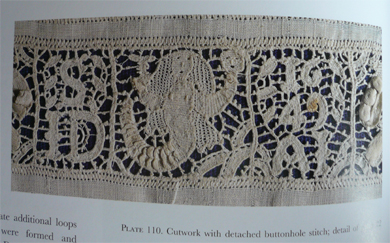 |
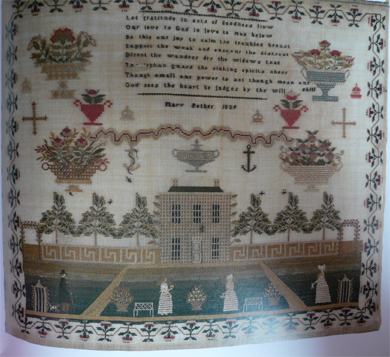 |
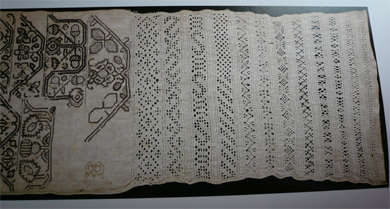 |
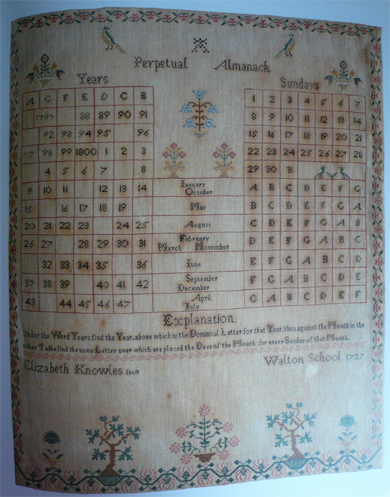 |
kitty: Ohio Is My Dwelling Place: Schoolgirl Embroideries, 1803-1850 - 0821414534
Ingram Annotation In this lavishly illustrated book, these now highly prized works are coupled with the stories behind their creations and the circumstances under which they were sewn. Ohio Is My Dwelling Place also includes an extensive chart of known pioneer teachers and schools in Ohio, as well as maps depicting the counties where the samplers were made. These samplers serve as a tangible and enduring legacy of Ohio's history, and readers will be intrigued and fascinated by the stories presented in this extraordinary keepsake volume. Kitty Kitty On many levels I think this is an amazing title. Rich in both Ohio history and also Children Embroidery Reference. Definitely a good reference book.
|
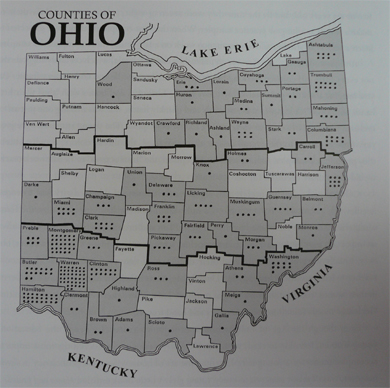 |
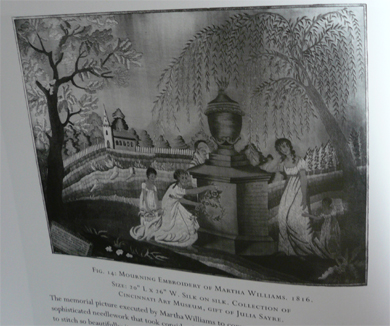 |
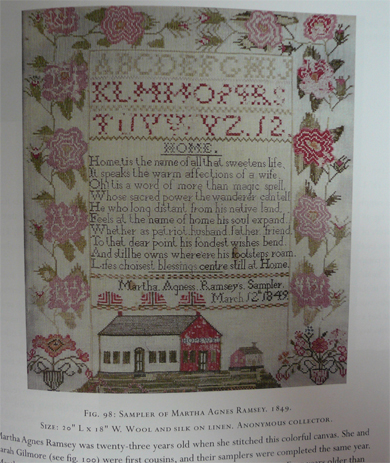 |
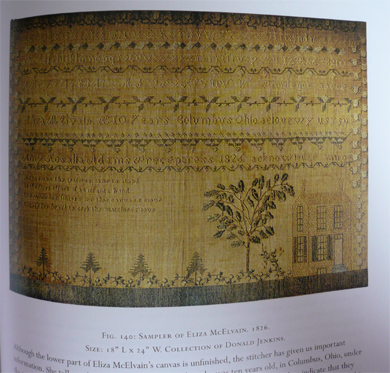 |
kitty: Samplers (Fitzwilliam Museum Handbooks) - 1851773096
Ingram Annotation Kitty Kitty: This was probably my favorite book, there are a wealth of examples and
a lot of different samplers that are not commonly seen in the other books. |
 |
 |
 |
 |
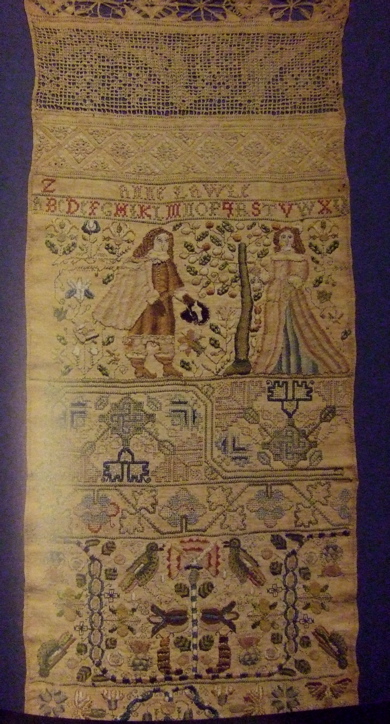 |
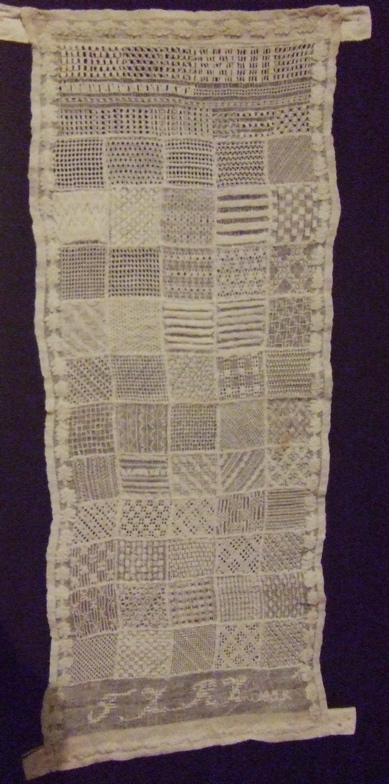 |
 |
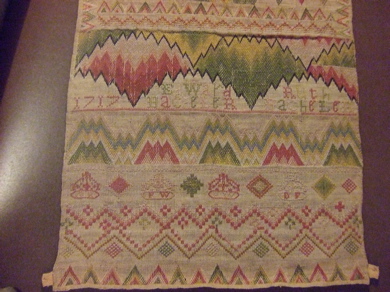 |
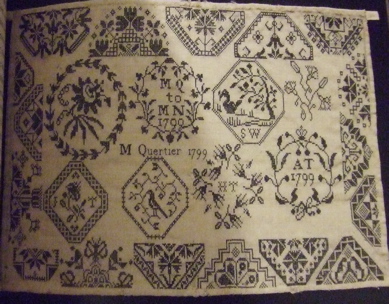 |
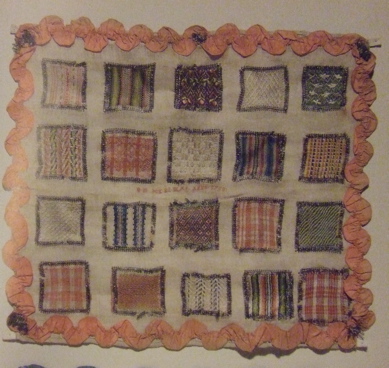 |
 |
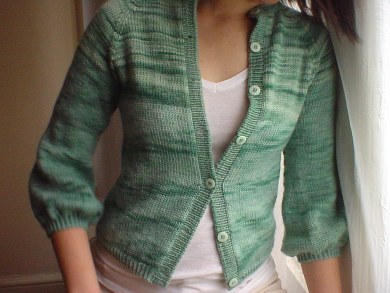

 Samplers:
From the Victoria & Albert Museum (Hardcover)
Samplers:
From the Victoria & Albert Museum (Hardcover) Ohio
Is My Dwelling Place: Schoolgirl Embroideries, 1803-1850
Ohio
Is My Dwelling Place: Schoolgirl Embroideries, 1803-1850 Samplers
(Fitzwilliam Museum Handbooks)
Samplers
(Fitzwilliam Museum Handbooks) 





